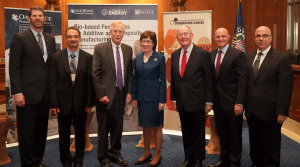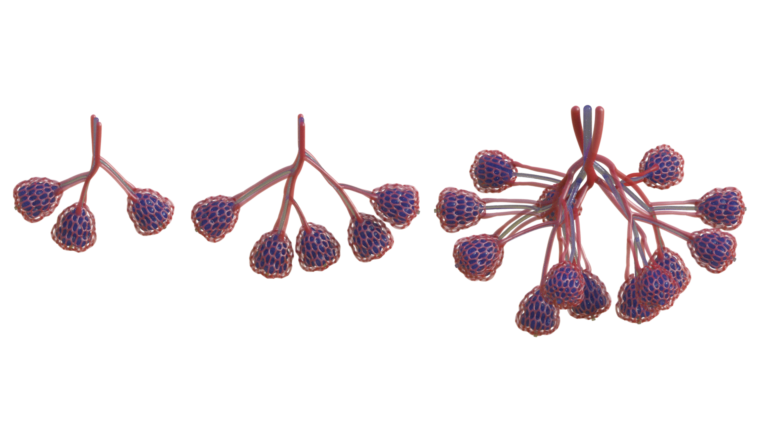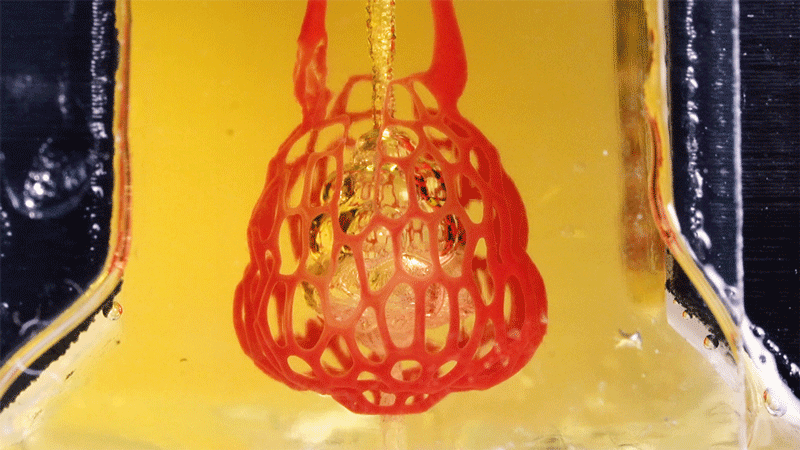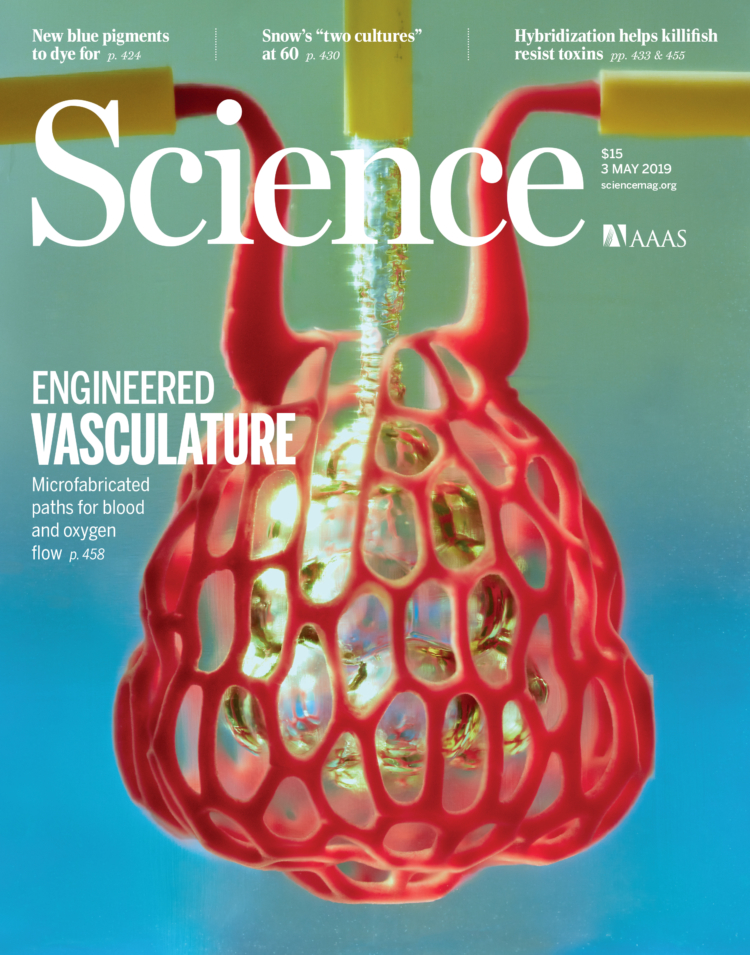New Aluminum Alloy Development Methodology for SLM Under Development
 Authors Qingboa Jia, Paul Rometsch, Sheng Cao, Kai Zhang, Xinhua Wung explain that SLM 3D printing users need some better choices for metals in their recently published, ‘Towards a high strength aluminum alloy development methodology for selective laser melting.’ Because of a limited selection materials, the researchers do not see SLM 3D printing living up to its true potential—especially for use in serious applications such as the automotive industry, aerospace, marine, medical and engineering.
Authors Qingboa Jia, Paul Rometsch, Sheng Cao, Kai Zhang, Xinhua Wung explain that SLM 3D printing users need some better choices for metals in their recently published, ‘Towards a high strength aluminum alloy development methodology for selective laser melting.’ Because of a limited selection materials, the researchers do not see SLM 3D printing living up to its true potential—especially for use in serious applications such as the automotive industry, aerospace, marine, medical and engineering.
Lightweight aluminum alloys are becoming more popular and are very ‘adaptable’ to SLM 3D printing. These types of alloys are still too limited, however, and the researchers point out that results in 3D printing are often mediocre—leading them to the option of creating a high-performance Al alloy.
Sc (scandium) is a metal element that can be used to strengthen a variety of different alloys—even in just small additions.
“During the SLM process, the solidification rate within molten pools measuring several hundred microns in size can go up to 104–106K/s, which provides the possibility of trapping significantly more Sc into solid solution. After a subsequent ageing treatment, the decomposition of the super saturated Sc in the Al matrix into a correspondingly large volume fraction of nano-sized Al3Sc precipitates provides great potential for precipitation hardening.
The researchers created an easy method to mimic the SLM printing process and predict alloy properties. A wedge mold casting and laser re-melting methodology were used to imitate the SLM solidification process. After that, the researchers were able to create Al-Mn-Sc alloy—both assessed and verified in SLM 3D printing. The ternary Al-Sc-Zr alloy demonstrated a usage hardening response, along with excellent thermal stability. Mn was also chosen as another element to add to the properties of the of the Al-Sc-Zr.
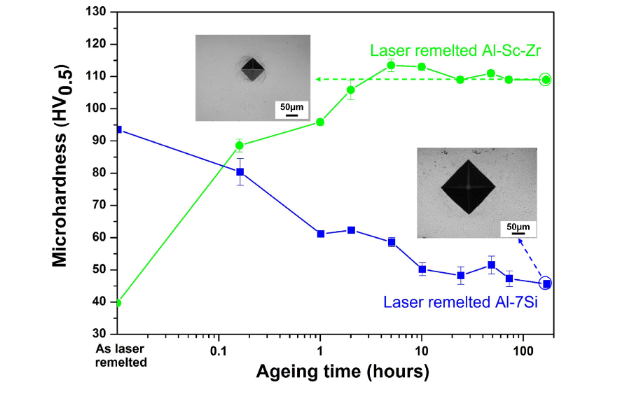
Ageing curves at 300 °C for laser remelted Al-Sc-Zr and Al-7Si alloys. The inset pictures show typical microhardness indentation sizes of samples aged for 168 h. Error bars that arenot showing up are typically within ±0.5 HV0.5
“The SLM-fabricated Al-Mn-Sc alloy demonstrated good laser processability with an absence of solidification cracks and obvious metallurgical defects. Due to the formation of primary Al3(Sc,Zr) particles at the molten pool boundaries, the SLM fabricated Al-Mn-Sc alloy possessed a fine columnar-equiaxed bimodal grain structure.”
“A TEM study confirmed the precipitation of a large volume fraction of nanosized Al3Sc precipitates after a simple and industrially desirable direct post-ageing treatment of 5 h at 300 °C. The direct aged Al-Mn-Sc alloy achieved very high yield strength of 570 MPa together with an elongation to fracture of 18%.”
Direct ageing treatment, and lack of fluctuation during the straining process could be a result of homogeneous distribution of precipitates along dislocation slip planes. The study shows that solutes like Mn, massive precipitation of nano-sizeed Al3Sc, and ‘fine-grained’ structures allowed for ‘outstanding qualities.’
While this work sheds light on new and improved alloys for SLM 3D printing, other materials have been created too such as high entropy alloys, titanium mixtures, and Ti6Al4V Cellular Structures. What do you think of this news? Let us know your thoughts! Join the discussion of this and other 3D printing topics at 3DPrintBoard.com.
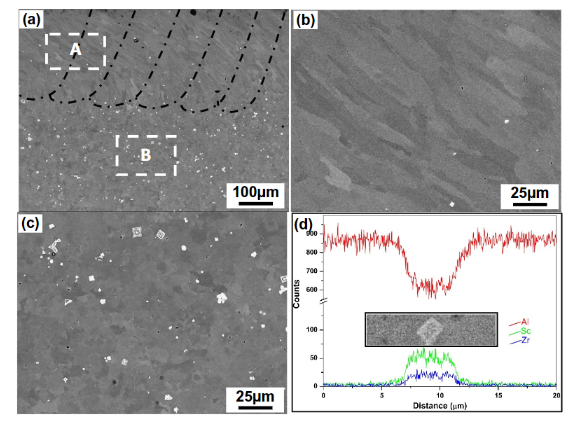
(a) Backscatteredelectron (BSE) images showing the cross-sectional microstructures of laserremeltedAl-Sc-Zralloy;(b) highmagnification image showing laser remelted area A in(a); (c) high magnification image showing cast area B in (a); (d) EDS line scan revealing the compos
[Source / Income: ‘Towards a high strength aluminium alloy development methodology for selective laser melting’]
Interview with Sylvia Heisel on 3D Printing in Fashion Today
Sylvia Heisel is a former fashion designer working with 3D printing, new materials, manufacturing and physical computing for fashion and wearables. She was named one of the “25 Forward Thinkers Defining the Future of Fashion”, “Top 100 Women in Wearable and Consumer Tech” and “12 Amazing People You Need To Know In New York Fashion Tech”, she consults, leads workshops and speaks on 3D printing, design for smart wearables and technology applications for sustainable fashion. Without further adieu let’s hear a little bit more about here story and 3D printing within fashion.
You have an impressive resume in terms of time within the fashion world. Could you give us some background on where you went to school and your passions that have evolved over time within the fashion industry?
I didn’t go to school. I did not study fashion. I dropped out of school. I was in New York and had already started making jewelry and selling it. I thought I was going to come back but I decided against it. I came from a family that treasured education. I came from a family where data was really important. My father is a retired demographer. It really helped. It killed them to know I was not going to college. But their background got me interested in tech at an early age.
=It seems that you evolved through your creative career? When do you remember specifically being interested in the intersection of technology and fashion?
I love fashion. Around 2007 a lot of the clothing stores I sold to were starting to have a lot of financial problems. These stores are not adapting to how the world is changing. People are going to buy stuff online. Lifestyles are different and people and fashion was not. I got into fashion because I loved what is new and creative. A lot of the clothing has not changed really. Retro 90s is not new. The digital and physical meeting is really interesting. My brand is focused on designing clothes differently in terms of working on AR. There is a software called Cloe for real clothing. A lot of people in fashion cannot adapt to this though.
I have seen some of your work in terms of 3D printed garments such as your custom 3D printed coat on the website. Where does a lot of your inspiration for design come from?
I think that a lot of it comes from the material and the technology there for making things. Some of it comes from other images. The coat was commissioned for this technology lounge in London. It had to be something everyone could fit into. Everything about 3D printing before then was focused on custom fits, so that piece was very interesting. Ninja Flex at the time was the only material that could be used. We were printing a lot of swatches at the time. Some ideas for visuals were mocked up and we had a lot of focus on something sleek and mysterious. Then we wandered into the realm of what can I make. We still are limited in terms of printers and the materials. It was all printed with desktop printers in bit by bit segments. This causes a design to be streamlined for simplicity. The software called morphee is useful for these type of ideas.
What is required to be a fashion designer in the digital age we currently live in?
A dream, a lot of hard work, and a good idea. I think that a combination of what can be done. You must know 3D printing. You must know a bunch of different technologies. You must have a bit of an idea what is actually is possible. A knowledge of the technology. It is also important to pay attention to your consumer and what they want.
Where do you see the industry of fashion going within ten years? You are considered one of the more influential designers when it comes to forward thinking design.
I do think there is a lot of amazing innovation. The design process is really different. The clothes will be very different. Customization will be key. A lot of new materials are coming. Biomaterials are coming which I think will change things a lot. Sowing and knitting will are going to be outdated. A lot of the clothes will be smart clothes as well. There will be so much cool technology integrated. We also have a giant industry that is in trouble. It is not changing well and it supports millions of people. As automation comes there will be a crisis when it comes to a bunch of people put out of jobs when it comes to robots. Sustainability will be a question to answer as well. We will have to focus on these realities too. I think mostly that clothing will also have function.
Who are some individuals in the field that you would suggest others be acquainted with as well?
I spend a ton of time finding and looking at a lot of different stuff and ideas. It is important to look at various media outside of what I know. I think there are so many brilliant people. I think it is important to absorb as much as possible. Instagram, linkedin, and going from thing to thing is great. I have a short attention span, so anything more than a minute long is too much. We just finished the Names Dress. It has 300+ women names in STEM fields. There are just so many people it is hard to bring them into light.
What are some resources for someone to learn more about 3D printing in terms of fashion design?
Join my meetup group. 3D print fashion. Follow 3D printing blogs of course. There are a few fashion tech resources but not a lot yet. Fashnerd is one. WTVOX. It is a really small community right now. LinkedIn and instagram are great. There is a lot of interest but there is no established community just yet. There is a lot of people split into the fashion side and cosplay which is cool. Then there are people who are just into sustainable fashion. There is a lot coming out in terms of the sneaker companies. Some people do not really like that trend.
If one wanted to get involved with fashion and technology in New York currently what would be the best route?
I do not think the where you are matters. I think making some cool stuff and getting it out there is important. I think New York is great for being super inspired. A lot of it is going to be online though. I honestly think that LA is even cooler pop up wise anyways. I think it is important to have people making stuff with technology first.
Adafruit Weekly Editorial Round-Up: 12,000 thank yous, Graduation Gift Guides, & more!

ADAFRUIT WEEKLY EDITORIAL ROUND-UP
We’ve got so much happening here at Adafruit that it’s not always easy to keep up! Don’t fret, we’ve got you covered. Each week we’ll be posting a handy round-up of what we’ve been up to, ranging from learn guides to blog articles, videos, and more.
BLOG
Adafruit Graduation Gift Guides 2019
Summer is coming up fast which means graduation season is approaching. Students who have put in the time and work towards their degrees, diplomas and certificates will be turning their tassels. If you have a graduate you want to congratulate with a gift, Adafruit has you covered. Read more!
More BLOG:
- 12,000 THANK YOUs! Celebrating 12,000 members in the Adafruit Discord Community!
- May is Asian Pacific American Heritage Month
- Celebrating 100 Volumes of New nEw NEWs From Adafruit
- Happy 6th Birthday MicroPython!
LEARN
In this project we’re 3D printing a Dragon Lamp!
This dragon was inspired by Game of Thrones and actually has the Night King riding on its back! It was designed by the 3Demon team and it’s a very detailed model with a high polygon count.
More LEARN
- Adafruit IO Basics: AirLift
- MakeCode Arcade Pixel Animation
- Multi-Sensor IoT Environmental Sensor Box With CircuitPython
- Sales Tax Exempt Accounts on Adafruit
Browse all that’s new in the Adafruit Learning System here!
RSNA Releases Guidelines for Medical 3D Printing
 Part of the thrill of 3D printing is in that sense of lawlessness: experiencing the ability to create and manufacture on a whim. In the medical field, however, rules and regulations are a good thing as none of us want to be misdiagnosed, treated with the wrong medications, or become the victim of a botched surgery.
Part of the thrill of 3D printing is in that sense of lawlessness: experiencing the ability to create and manufacture on a whim. In the medical field, however, rules and regulations are a good thing as none of us want to be misdiagnosed, treated with the wrong medications, or become the victim of a botched surgery.
The Radiological Society of North America (RSNA) is taking 3D printing very seriously as a technology that can be integrated with radiology, but they are also promoting consistency and safety, as outlined in their document, ‘Radiological Society of North America (RSNA) 3D printing Special Interest Group (SIG): Guidelines for medical 3D printing and appropriateness for clinical scenarios,” written by volunteer members.
 Ambitions toward creating printing guidelines have been in the works since 2016 with the approved creation of the Special Interest Group on 3D Printing.
Ambitions toward creating printing guidelines have been in the works since 2016 with the approved creation of the Special Interest Group on 3D Printing.
“These practice parameters and recommendations are not intended as comprehensive standards but do reflect several salient aspects of clinical anatomic modeling and appropriateness,” state the authors.
Using 3D printing to create models for patient-specific care includes the following steps:
- Image acquisition
- Image segmentation
- Creation of 3D printable file types
- 3D printing
- Post processing of models

3D printing is already transforming healthcare in many revolutionary ways (Image: RSNA)
The point of the RSNA document is to offer recommendations on the 3D printing of medical models, including ‘point-of-care manufacturing’ in hospitals and clinical settings. Content for the document was discussed during several different meetings of the RSNA Special Interest Group for 3D Printing, with recommendations covering the following parameters for 3D printing:
- Spatial resolution and slice thickness
- Signal to Noise Ratio (SNR) and Contrast to Noise Ratio (CNR)
- Image artifacts
- Image data preparation and manipulation
- File storage and descriptors
- Reference to file manipulation and alteration
Of special interest is the recommendation regarding 3D printed models:
“When 3D printed models are generated from medical images, the resolution of the 3D printer should be equal to, or superior to that of the clinical images used to segment the model.”
“… Printed models are assumed to be of anatomic size (1:1) unless a scaling factor is otherwise noted. Additional identifiers such as model sidedness (left, right) should be noted, as appropriate. Institutional guidelines should be used to verify models are free of protected health information, or models are handled appropriately in accordance to Health Insurance Portability.”
Supporting materials should be removed completely, and if a 3D printed model is defective and cannot be repaired, it should be re-printed. Not only should models be inspected fully, but so should 3D printers, being assessed for continued accuracy, including test prints, preventative maintenance, and recalibration.
And regarding bioprinting:
“Manufacturers should provide cleaning recommendations and specifications for materials which have been formally tested for biocompatibility and sterility, and these specifications should be followed by the facility. Additional internal sterilization policies may exist depending on the hospital.”
Additionally, the document also goes into detail discussing many different specific descriptions submitted by the SIG writing group for each clinical group.
3D printed models are becoming more prevalent in the medical field, whether as training devices for medical students and surgeons or use in simulation but issues have been raised more often lately too regarding guidelines and quality assurance methods. Find out more about RSNA guidelines here, as trends continue in accountability for 3D printing.
What do you think of this 3D printing news? Let us know your thoughts! Join the discussion of this and other 3D printing topics at 3DPrintBoard.com.

The Radiological Society of North America (RSNA) is a non-profit organization with over 54,000 members from 136 countries around the world. (Image: RSNA)
[Source / Images: Radiological Society of North America (RSNA) 3D printing Special Interest Group (SIG): Guidelines for medical 3D printing and appropriateness for clinical scenarios]
WebTuner: scroll through all open tabs with a rotary dial
A funny idea that turned into a pretty funcional WebTuner. Find your tabs the same way you [used to] pick a radio station!
Shared by Zoé on Hackaday.io:
I realized I had way too many browser tabs open, and the silly idea came to me; how hard would it be to make a hardware knob to switch between them?
Turns out Native Messaging is a viable way to get data from an USB/serial port into your Firefox extension, which has a nice API to access the tabs.
I created a mount for my thinkpad X220, a knob, picked a rotary encoder and an arduino, and the whole thing was done in an afternoon. Elen wrote the extension, I made the firmware, both of which are very simple.
Learn more and check out the GitHub page for files
ORNL and UMaine Initiative Receives Funding to Create New Bio-Based 3D Printing Materials

UMaine Advanced Structures and Composites Center students and staff lift a boat roof from a mold 3D printed with a new biomaterial, nanocellulose-reinforced PLA, developed at the University of Maine. L-R: Michael Hunter, Camerin Seigars, Zane Dustin, Alex Cole, Scott Tomlinson, Richard Fredericks, and Habib Dagher. [Image: UMaine]
The researchers at Oak Ridge National Laboratory (ORNL) in Tennessee have spent a lot of time working with unique 3D printing materials, such as polyester, lignin, and nanocellulose, which is a bio-derived nanomaterial. Now, a new research collaboration between ORNL and the University of Maine’s Advanced Structures and Composites Center aims to increase efforts to use wood products as 3D printing materials. Together, the team will work with the forest products industry to create new bio-based 3D printing materials that can be used to make products like building components, boats and boat hull molds, wind blades, and shelters.
The large-scale initiative was announced this week in Washington, DC. Leaders from the university and ORNL, as well as the DoE‘s assistant secretary for energy efficiency and renewable energy Daniel Simmons, the founding executive director of the Advanced Structures and Composites Center Habib Dagher, and US Sens. Susan Collins, Lamar Alexander, and Angus King were all on hand for the announcement, which also stated that UMaine and ORNL had received $20 million in federal funding for the program from the DOE’s Advanced Manufacturing Office.
“While Oak Ridge is a global leader in additive manufacturing, the University of Maine is an expert in bio-based composites. By working together, they will strengthen environmentally responsible advanced manufacturing in America as well as helping the forest industry in the state of Maine,” Senator Collins said.
Sens. Collins and King requested federal help to save the declining forest products industry in Maine back in 2016, after several paper mills in the state closed their doors. This led to the founding of the Economic Development Assessment Team (EDAT) to work across agencies in order to come up with economic development strategies for the rural communities in Maine that were suffering from the mill closures. This team resulted in the ongoing partnership between UMaine and ORNL.
“Using Maine forest products for 3D printing is a great way to create new jobs in Maine and a good reminder that national laboratories are our secret weapons in helping the United States stay competitive in the rapidly changing world economy. The partnership between the University of Maine and the Oak Ridge National Laboratory is a model for how science and technology can help Americans prosper in the new economy,” said Senator Alexander.

A 3D printed representation of the state of Maine presented by Habib Dagher, executive director of UMaine’s Advanced Structures and Composites Center. The material was a wood-based product developed at UMaine. [Image: Contributed by the office of Sen. Susan Collins]
This October, ORNL’s BAAM 3D printer will be installed at UMaine, which is actually considered a world leader in cellulose nano fiber (CNF) technology. UMaine students can also visit ORNL’s Manufacturing Demonstration Facility (MDF), while staff from the laboratory can in turn learn about cellulose fiber and composites at UMaine’s composites center.
One of the printer’s first tasks will be to fabricate a boat mold out of a wood-based plastic, though the team hopes to apply the technology to many large-scale manufacturing applications.

Habib Dagher, Executive Director of the Advanced Structures & Composites Center holds up 3D printed representations of Maine and Tennessee signifying new manufacturing programs between UMaine and ORNL that will use wood-based products in 3D printing. Sen. Angus King, I- Maine, and Sen. Susan Collins, R- Maine, watch Dagher’s presentation after announcing $20 million in federal funding for the collaboration. [Image: Contributed by the office of Sen. Susan Collins]
Dagher explained, “The material is nanocellulose, basically a tree ground up to its nano structure. These materials have properties similar to metals. We are taking those and putting them in bioplastics so we can make very strong plastics that we can make almost anything with.”
The team will then add the nanocellulose to PLA.
“The University of Maine is doing cutting-edge research related to bio-feedstocks and the application of advanced manufacturing in regional industries,” said Thomas Zacharia, the director of ORNL. “We are thrilled at this opportunity to expand our research base while providing UMaine with access to the leading national capabilities we have developed at ORNL’s Manufacturing Demonstration Facility.”
The overall goal for the initiative is to find new uses for wood-based products in an effort to reinvigorate Maine’s forest products industry, while also helping to make regional manufacturing stronger by connecting university–industry clusters with the MDF. The federal funding will be divided equally between both facilities.
“We will integrate 20 years of research in bio-based composites at UMaine and 3D printing at ORNL. It is an opportunity engine for our students, faculty, staff and manufacturing industry who will work side by side with researchers at our nation’s foremost research laboratory. Together, we will break down wood to its nanocellulose structure, combine it with bioplastics, and print with it at hundreds of pounds an hour,” said Dagher. “The research we will be conducting with ORNL will spur next-generation manufacturing technologies using recyclable, bio-based, cost-effective materials that will bolster our region’s economy.”
Scientists from UMaine and ORNL will be conducting research in multiple areas, such as multiscale modeling, CNF production, drying, functionalization, and compounding with thermoplastics, and sustainability life-cycle analysis.
CNF could actually rival the properties of steel, and by successfully adding it into plastics, the researchers could create a renewable feedstock for strong, recyclable, bio-derived material systems that might even be 3D printed at deposition rates of hundreds of pounds an hour. Additionally, using a material that’s 50% wood could help open new markets for the forest products industry.
UMaine will get world’s largest 3D printer and use wood-based plastic to make boat molds
Discuss this story and other 3D printing topics at 3DPrintBoard.com or share your thoughts in the Facebook comments below.
Nervous System Works with Rice University Researchers 3D Printing Vascular Networks
Nervous System has been heavily engaged in experimenting with 3D and 4D printing of textiles in the past years, and all their research is paying off now as they find themselves engaged in the realm of tissue engineering. The Somerville, MA company is known for their generative design process, combining both programming and art within most of their serious projects, drawing bioengineers from Rice University to turn to them for added expertise.
Assistant professor Jordan Miller invited the Nervous System team to join his researchers on an incredible journey to fabricate examples of possible vascular networks via bioprinting—harnessing their knowledge of software and materials to find a way to create soft hydrogels. Kind of not a phantom but more a path towards ideas that can lead to concepts that may let us build true vascularized structures at one point. As Miller explains, in their research they were able to create large tissue blocks easily, but as so many scientists engaged in bioprinting today have discovered before them, it is extremely challenging to keep cells alive. Viability becomes the goal, and as that becomes more comprehensively mastered overall in bioprinting, it may finally unlock the door to true fabrication of organs that can be transplanted into the human body.
Open-source technology, mainly centered around 3D printing has offered huge opportunity for the bioengineers from Rice University to make progress in their work—and that was what drew them to Nervous System in the first place. Jordan became ‘captivated’ with the structures they were creating, specifically in their Growing Objects series, which was featured as an exhibit at the Simons Center for Geometry and Physics in Stonybrook, NY in August and September of 2014. In speaking with Nervous System, his proposal involved what they describe as an ‘epic task,’ to create simulated synthetic tissue and human organs.
“The idea of taking our generative systems which are inspired by nature and using them to actually make living things was a dream come true,” states the Nervous System team in their case study.
Elsewhere the research did,
“…show that natural and synthetic food dyes can be used as photoabsorbers that enable stereolithographic production of hydrogels containing intricate and functional vascular architectures. Using this approach, they demonstrate functional vascular topologies for studies of fluid mixers, valves, intervascular transport, nutrient delivery, and host engraftment.”
As Miller and his expanding team continued to work on developing the necessary tools for bioengineering, part of their research resulted in a new 3D printing workflow called SLATE (stereolithography apparatus for tissue engineering). Their proprietary hardware can bioprint cells encased in soft gels that act just like vascular networks. Nervous System accompanied them (going back as far as 2016) in this bioprinting evolution by designing the materials for the networks—but with their background in programming, the contribution went far beyond designed materials and included customized software for creating ‘entangled vessel networks.’ These networks can be connected to both inlets and outlets for oxygen and blood flow, as they use specific algorithms to ‘grow’ the branching airways.
“Air is pumped into the network and it pools at the bulbous air sacs which crown each tip of the network,” states Nervous System in their case study. “These sacs are rhythmically inflated and deflated by breathing action, so called tidal ventilation because the air flow in human lungs is reminiscent of the flows of the ocean tides.
“Next we grow dual networks of blood vessels that entwine around the airway. One to bring deoxygenated blood in, the other to carry oxygen-loaded blood away. The two networks join at the tips of the airway in a fine mesh of blood vessels which ensheathes the bulbous air sacs. These vessels are only 300 microns wide!”
This project, bringing together scientists and art designers, was featured in the American Association for the Advancement of Science (AAAS) in ‘Multivascular networks and functional intravascular topologies within biocompatible hydrogels,’ authored by Bagrat Grigoryan, Samantha J. Paulsen, Daniel C. Corbett, Daniel W. Sazer, Chelsea L. Fortin, and Alexander J. Zaita.
The recently published article goes into great detail about SLATE 3D printing, indicating that this hardware is capable of rapid bioprinting, and offering possible sustainability to human cells—along with maintaining functionality of stem cells and necessary differentiation.
The project was created by Jordan Miller at Rice University and Kelly Stevens at the University of Washington, and included 13 additional collaborators from Rice, University of Washington, Duke University, and Rowan University.
What do you think of this news? Let us know your thoughts! Join the discussion of this and other 3D printing topics at 3DPrintBoard.com.
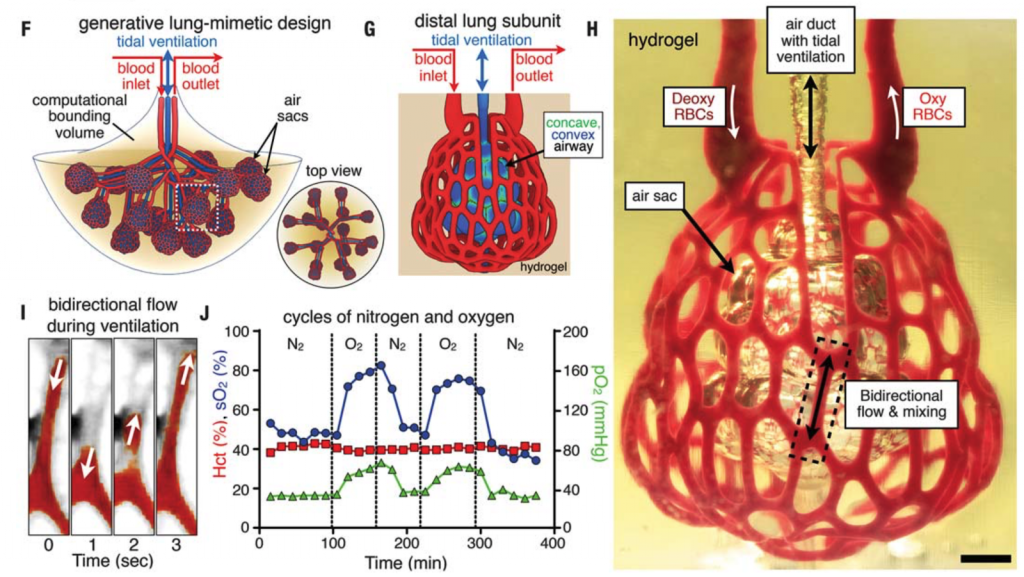
The Miller Lab fabricated and tested the architectures we generated showing that they can withstand more than 10,000 ventilation cycles while being perfused with human red blood cells. Study of the printed gels shows that the architecture we designed promotes red blood cells mixing and bidirectional flow which is hypothesized to occur in the human lung.
[Source / Images: Nervous System]
Interview With Kevin Neugebauer of myprintoo on 3D Printing in Germany
German 3D Printing reseller and store myprintoo is a popular Hamburg based destination site for buying 3D printers and supplies. As with the other 3D printing retailers and resellers that we’ve interviewed for this series myprintoo is shifting its focus more towards the enterprise. They sell Materialise Magics, Artec Studio as software and also have consulting services. The company also offers professional level printers from third wave 3D printing companies such as Xact Metal, 3ntr, and Ansioprint. With Formlabs equipment, 3D scanners, Ultimaker and Sinterit the firm focuses on the higher end of the desktop market as well as entry-level manufacturing solutions. This cauldron of activity is currently a very profitable but also a very competitive space in 3D printing. We interviewed Kevin Neugebauer to find out more about his firm and the 3D printing market in Germany.
What is myprintoo?
myprintoo is a specialist in 3D printing technology. Our 3D printing retail store ranked number three amongst the ten most popular 3D printing online stores 2018 (according to 3druck.com).
What makes us different from most of the online shops selling 3D printing products? We offer not only products from the top 3D printing manufacturers, but we also provide all-round services for 3D printing technology. If only buying a 3D printer was as easy as buying a regular 2D printer! Here you need to know precisely what you will use it for. Will it improve your everyday life, and will it save resources? Will you be able to operate it?
We consult with our customers and find suitable solutions for their 3D printing applications together. We also discuss further possible applications of the 3D printing technologies, so that their investment pays off in the future as well. If our customers have any technical questions, we gladly support them in the German and English.
Additionally, we offer webinars and product training in Hamburg or on-site, to show the customers how to work successfully with the hardware and software and which procedure is best suited for their application. We also work closely with educational establishments by providing them with information and professional guidance on 3D printing.

The core myprintoo team; Kevin is seated.
What markets do you focus on?
We focus on the B2B markets – mostly in the German-speaking area. For some of our products we have exclusive rights to the DACH region, for some – additionally, to the Benelux Union.
What kind of customers do you have?
Our customers come from different branches and industries: mechanical engineering, automotive, aerospace, R&D departments, universities, laboratories, medical establishments. They all have different demands and applications and require different approaches.
These are
a) customers who are new to 3D printing,
b) customers who got familiar with 3D printing some time ago, are developing their applications and need more professional 3D printers,
c) advanced users who require professional solutions for their specific needs.

How is your product portfolio structured?
According to our customer’s types, we differentiate our products as follows:
- Products that are well suited for beginners – these are the desktop 3D printers Ultimaker and Formlabs.
- To those who need a professional solution in FDM we offer our two 3ntr 3D printers – A2 and A4 – they score with an open system for a high variety of materials. Three nozzles allows the printing of parts with a combination of two different colors and/or properties while at the same time printing utilizing support material – necessary for complex geometries. These machines are ideal for prototyping, product development, printing of spare parts and demonstration objects, for example for medical institutions.
- To customers who want to print with titanium, aluminum, stainless steel & bronze we offer our two 3D metal printers – Xact Metal XM200C and XM200S. Both are perfectly suited for taking the first steps in the metal 3D printing. Their compact design and best price-performance value makes them attractive for mechanical engineering and automotive, while affordable for universities and R&D centers at the same time.
-
To Aerospace & Automotive customers, who need to 3D print extremely light but, simultaneously, strong parts with high mechanical load capacity, we offer the Anisoprint Composer series A4 to A2. It’s a 3D printer capable of printing with high-strength composite materials, using special reinforcing carbon fiber along with the common plastics, which gives the parts superior mechanical properties. Universities and research centers profit from experimenting with continuous carbon fiber as well.
Why should I work with you?
For almost 5 years we have been delivering not only professional 3D printing technology, but also knowledge essential for the 3D printing. Our team has been gathering experience in different branches like 3D printing, chemistry, architecture, design, IT and sales so that our solutions are tailor-made to meet the needs of our customers.
We support our customers during their first steps in 3D printing and enable the transfer from desktop to professional 3D printers. We see ourselves not only as consultants who help finding the best solutions, but also as project partners who are interested in successful results.

I keep thinking that maintenance and service will be key to reseller profits in the future?
Of course, being supported when having technical questions, a customer can start 3D printing immediately. To prevent long repairs and downtimes we offer additional annual maintenance contracts for our brands 3ntr, Xact Metal & Ultimaker. Our technicians inspect the purchased 3D printer on site or at our service desk in Hamburg and replace spare parts when necessary. We also give expert advice reliably and quickly on the phone and via e-mail.
What is the market like in Germany?
3D printing is gaining more and more popularity in Germany. We all hear: “3D printing is revolutionizing the industry!” What is really happening is that the top companies mostly in the automotive and aerospace industries are purchasing the high-end products of the well-known 3D printing brands.However, there are many small and medium-sized enterprises who want to be involved in 3D printing as well, but cannot afford the high-end 3D printers. Meanwhile, the low-cost, high-performance professional 3D printers already exist and guarantee successful introduction into 3D printing. Our goal is to inspire the smaller companies, to let them know that 3D printing is getting affordable and that they could, if not revolutionize the industry, at least optimize their own production site.

What are the stumbling blocks in 3D printing?
-
The biggest problem is that it’s not that easy to recognize the applications and the added value of the 3D printing.
-
People keep printing conventional parts, sometimes not knowing what parts are best suited for the 3D printing. However, modifying the design of the parts can help evolve the manufacturing process and save resources.
-
In-house knowledge in 3D printing technology is limited.
What advice would you give me if I was a company new to 3D printing?
First, find a reliable team of experts in 3D printing technology, like myprintoo. Tell them your applications, ideas and even doubts. Believe me there’s a solution for every implementation.
Buy a 3D printer together with a webinar or a product training – that’s how you ensure a smooth software installation, impeccable hardware operation and the fastest ROI.
Research what parts are best suited for 3D printing or the ways you can optimize the parts to get more value out of 3D printing.
Keep in touch with us – that’s how we can evaluate, whether you are getting the best out of the 3D printing technology. Additionally, we offer upgrade programs for customers who want to trade their old machine in for a new professional 3D printer.
How do you see our industry evolve?
I imagine fully automated production lines with non-stop manufacturing processes involving 3D printers not only printing prototypes and spare parts, but totally new end products with modified designs, properties and customized tailor-made solutions.
I believe in the near future any respected educational establishment should have a 3D printing lab to prepare the new open-minded experienced professionals who will continue revolutionizing our industry.
Issue 18 – HackSpace magazine “3D-printed jacket mod with LEDs” by @SophyWong #Wearables #CircuitPlaygroundExpress #Adafruit @HackSpaceMag @Adafruit @MSMakeCode

Issue 18 — HackSpace magazine – a 3D-printed jacket mod with LEDs by designer & maker Sophy Wong.
In our project, we’ll use a simple pattern of extruded hexagons, and make two 3D-printed panels that will be sewn to the back of a jacket. We’ll pattern our pieces directly off the jacket so that they fit perfectly. Translucent filament is a fantastic diffuser for LEDs, so we’ll add some lights to the back of the jacket. We’ll control our LEDs with an Adafruit Circuit Playground Express, using its on-board buttons to switch between animations. If you’ve never programmed a microcontroller before, the Circuit Playground Express (CPX) is the perfect place to start. Coding the CPX is simple with MakeCode, an online block-based visual programming tool from Microsoft. The finished piece will be a programmable, 3D-printed LED jacket, fit for your next cyberpunk adventure!
See the entire six page tutorial in Issue 18 of HackSpace Magazine, PDF (pages 100 to 105).








